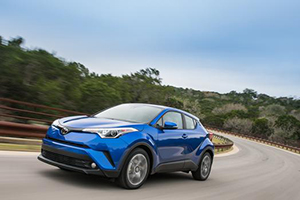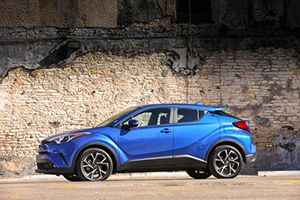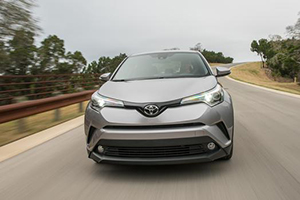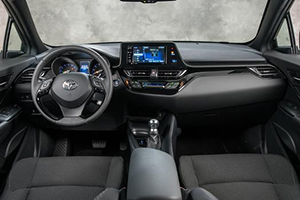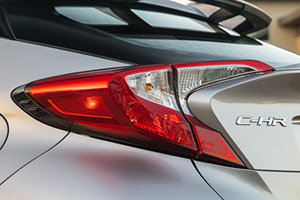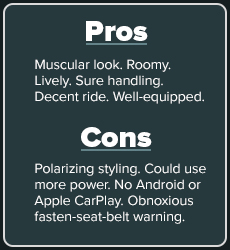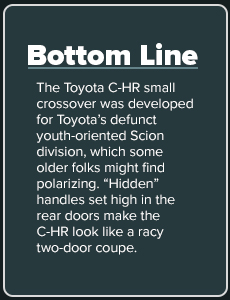2018 Toyota C-HR
Prices: $22,500-$24,350
Some may think the Toyota C-HR—or Coupe High Rider—is an
off-roader. It's not because it doesn’t have lots of ground
clearance and comes only with front-wheel drive. However, it does fine
as a roomy, conveniently sized crossover for the road.
The C-HR is a hatchback that comes in $22,500 base form and as the
$24,350 XLE Premium version, which I drove. My test C-HR was painted a
nice Blue Eclipse metallic, but I would have preferred the available
Ruby Flare Pearl paint with the optional white roof and side mirrors.
Even the base model is fairly well equipped with such things as power
windows, a leather-wrapped tilt/telescopic wheel, backup camera (with a
rear display in the inside rearview mirror), dual-zone climate control,
front bucket seats with side bolsters and a 6-speaker AM/FM/CD
radio—but no Android or Apple CarPlay.
The XLE Premium adds items including a pushbutton start, power lumbar
driver’s seat, heated front seats, remote keyless entry,
blind-sport monitor, rear cross-traffic alert and color keyed power
outside mirrors with turn signal indicators that fold against the side
glass when the car is parked to prevent damage.
All C-HRs have full speed-range dynamic radar cruise control and a
pre-collision system with automatic braking.
The engine is a 2-liter four-cylinder with dual overhead camshafts and
16 valves, hooked to a decent CVT automatic transmission with a
responsive manual-shift feature controlled by the console-mounted
shifter. The engine generates 144 horsepower and 139 pound/feet off
torque. Acceleration is decent, but the C-HR weighs 3,300 pounds so a
little more power and torque would be welcome.
Estimated fuel economy is 27 miles per gallon in the city and 31 on
highways. The fuel tank swallows 13.2 gallons, and the
owner’s manual says the C-HR can use either 87
octane “or higher” octane gas.
It takes a slight step up to reach the comfortable interior, where the
61.6-inch-high C-HR lets occupants sit a little higher than they would
in most cars. There’s good front/rear head room. But rear leg
room for a long-legged passenger isn’t overly generous behind
the driver in the 70.7-inch wide vehicle, which is best suited for four
occupants. The 103.9-inch wheelbase C-HR is 171.2 inches long, and its
handy size makes it easy to move quickly in traffic.
The hatch swings up on twin struts and has a wide, but somewhat high,
opening. Cargo room is fairly decent, and split rear setbacks fold
forward and sit pancake flat to increase cargo volume from 19 cubic
feet to 36.4 cubic feet.
Fairly light, quick electric power steering helps make the C-HR easy to
handle. The supple ride is on the soft side. An all-independent
suspension with double wishbones at the rear, stiff body structure,
50-series tires on 18-inch wheels and vehicle stability and traction
controls allow the C-HR to be secure at above-average speeds around
curves. The brake pedal has a linear action, and the anti-lock brakes
with electronic brake force distribution ensure fast, secure stops.
The quiet, attractive interior of my test C-HR XLE Premium had
soft-touch materials, tilt/telescopic steering wheel, unusually
supportive front seats and plenty of cupholders, although the
“fasten-seat-belt” buzzer was obnoxiously loud.
Large manual climate controls were appreciated, and the 7-inch
touchscreen for the audio system could be easily used. A 4.2-inch color
multi-information display came in handy for various drive data. It
displayed such things as outside temperature, fuel economy, a G-force
monitor and warning messages.
Safety features include regular air bags and front and rear side
curtains.
The hood is extremely heavy and held open by just a prop rod, although
most fluid filler areas can be easily reached.
Despite its appearance, the C-HR is more pleasant and practical than
sporty, although there’s nothing wrong with looking
snazzy—even without the Ruby Flare Pearl paint.
